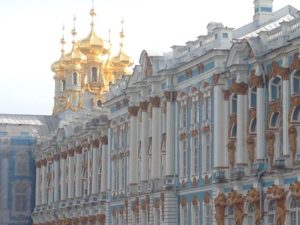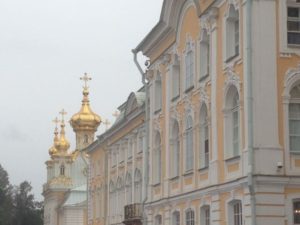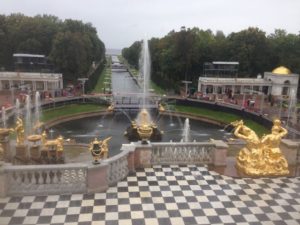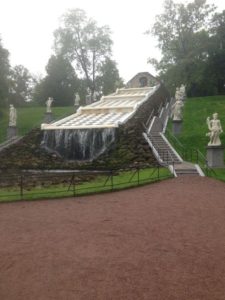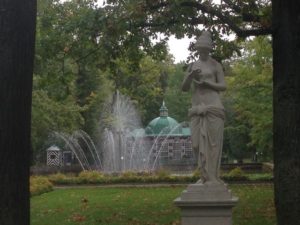Pushkin, also known as the town of the czars, is about 40 mins from St. Petersburg, and home to the Alexander Palace and the Catherine Palace. We first passed the Alexandre Palace, which was a gift from Catherine the Great to her grandson Alexander, who is the ruler who defeated Napoleon when he made the mistake of invading Russia.
The Alexander Palace was the favorite home of Czar Nicholas II. The family believed that the best way to keep it secret that their son, Alexis, was a hemophiliac was to live away from the capital, which turned out to be a tragic mistake. The family spent only 11 days in St. Petersburg, which contributed to the czar’s lack of understanding of the political situation in the city. When he was forced to abdicate, he and his family were placed under house arrest in the Alexander Palace, and it was from there they departed, never to return.
The Catherine Palace or the Summer Palace was named after Catherine I, wife of Peter the Great (PTG), who ruled Russia for only two years after his death.
PTG got the idea for summer houses from the Dutch, therefore the name, dacha for summer house in Russian. PTG gave the land to his first wife, Catherine, and while he was on one of his tours of Europe, she had a 16 room wooden summer house built on the land. When PTG daughter, Elizabeth ascended to the throne, she had it rebuilt into a 300 room Baroque palace, completed in 1756. It was intended to rival Versailles, and indeed it does, but on a smaller scale.
Our first glimpse of the palace was of the gold domes of the Royal Chapel (not yet restored, but due to be opened in 2020). 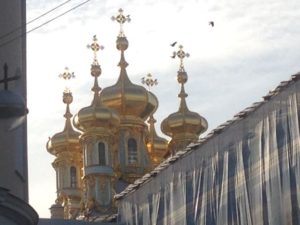 The blue and white exterior is decorated with hundreds of statues that were covered in gold leaf in Elizabeth’s time.
The blue and white exterior is decorated with hundreds of statues that were covered in gold leaf in Elizabeth’s time.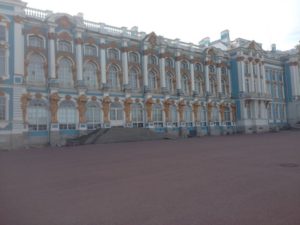
The primary architect was Bartolomeo Rastrelli, who also designed the Winter Palace, the Peterhof Palace, and many other palaces in and around St. Petersburg.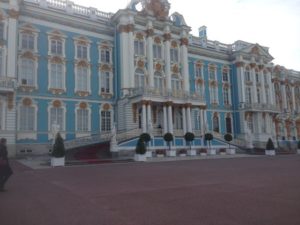
Elizabeth was the great enlarger of all of PTG’s palaces. She had 69 palaces and is said to have owned 15,000 gowns. Her coronation gown weighed 80 pounds, and the ceremony for which she had to stand, lasted 7 hours.
When Catherine the Great ascended to the throne after her husband’s death. She disliked the ornate style of the palace and had it redesigned in neoclassical style and had the gold removed from the statues.
In spite of Stalin’s 1939 nonaggression pact with Germany, Hitler invaded Russia in 1941 and reached the outskirts of St.Petersburg in 6 weeks, beginning the 900 day siege of St. Petersburg, in which an estimated 2.5 million people died of starvation and of bombing. During the worst winter on record, (1941-42), 6 to 7 thousand people died each day in the city.
Before the Nazis reached The Catherine Palace, most of the paintings and precious objects were removed, but the most famous room, the Amber Room was not evacuated. The panels of mosaic amber were originally presented to PTG by the King of Prussia, but were stored and forgotten until Elizabeth rediscovered them and had them installed in the Catherine Palace. When the Nazis took over the palace, they promptly took down the amber panels and packed them in crates and shipped them out to Koenigsberg. The panels that made up the Amber Room have never been located. When the Nazis retreated, they destroyed most of the Catherine Palace, just as they did the Peterhof Palace.
Only 20 of the 300 rooms have currently been restored. The Light Gallery or Throne Room was used as a ballroom and reception room and was lit by over 2 thousand candles.
Even though the Catherine Palace is a summer palace and was not used in winter, most of the rooms were heated with floor to ceiling blue and white porcelain heaters.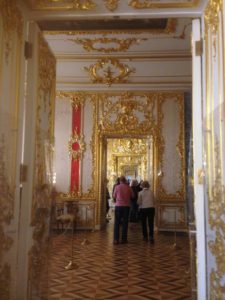
The Amber Room is the most famous room. It is a replica of the original, begun in 1979 and completed in 2002 at a cost of over 28 million Euros. No photos are allowed in the Amber Room, but I was able to take pictures from a guidebook I purchased.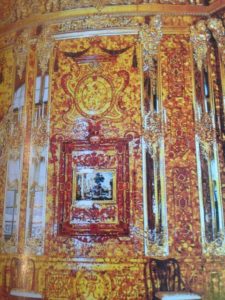
The Picture Gallery contains paintings contributed by CTG, but not her favorites, and the paintings were used much like wallpaper to cover every inch of the walls.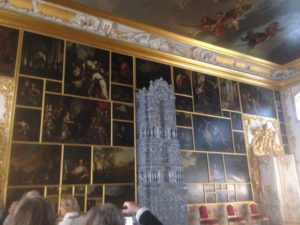
Each room is very different. The Cameron room, named after the man who designed it (also the man who excavated Pompeii) is also called the Wedgwood Room for obvious reasons.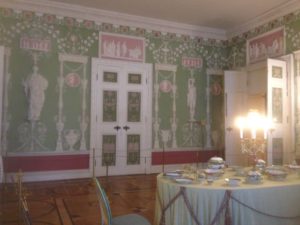
The Gardens of the Catherine Palace are also quite spectacular.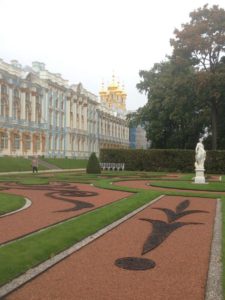
Peterhof Park and Gardens was PTG’s official summer residence. It is surrounded by 2 parks with 700 acres. Like the Catherine Palace, the architect was Bartolomeo Rastrelli, and it was significantly enlarged by his daughter Elizabeth in the mid 1700’s. Also, like the Catherine Palace, it was destroyed by the Nazis during WW II. The restoration of the gardens was completed in 2003.
We didn’t see the interior of the palace, but it is not supposed to be as grand as the Catherine Palace. Catherine the Great did not like the Peterhof Palace because she and her husband were deficit prisoners here when Elizabeth wanted her to get pregnant (after 8 years of marriage). She did get pregnant, but there is speculation about whether the father was her husband or one of the handsome guards.
The main attraction at Peterhof is the gardens.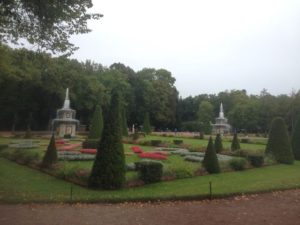
Even though it was rainy when we were there, the gardens and many fountains were lovely.
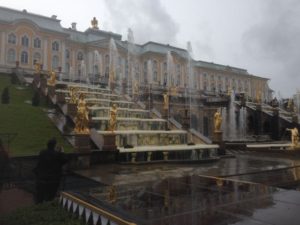
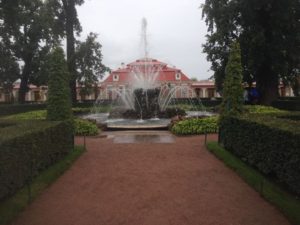
The garden is located on the Gulf of Finland across from St. Petersburg, and we saw catamarans arriving and departing, undoubtedly from the city.
To create this extraordinary chamber, Rastrelli used the panels of amber mosaic originally destined for an Amber Cabinet at Konigsberg Castle and presented to Peter the Great by Friedrich-Wilhelm I of Prussia, and surrounded them with gilded carving, mirrors, more amber panels created by Florentine and Russian craftsman (comprising a total of 450kg of amber), and further mosaics of Ural and Caucasus gemstones. The room was completed in 1770. Due to the fragility of the materials used, a caretaker was employed constantly to maintain and repair the decorations, and major restoration was undertaken three times in the 19thcentury. The room was used to house a substantial collection of amber-work and Chinese porcelain. In 1941, when German troops took Tsarskoe Selo, the Amber Room was dismantled in 36 hours, and shipped to Konigsberg in a tawdry pretence at historical fidelity. As the Nazi war machine crumbled, the panels were crated up and moved out of danger, but their eventual fate is unknown.




